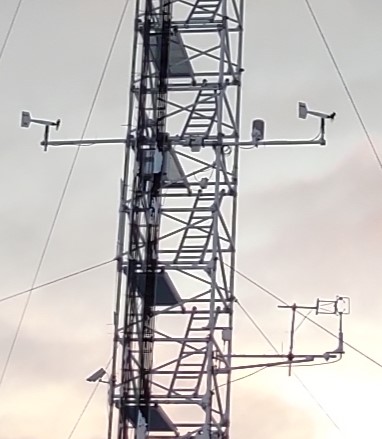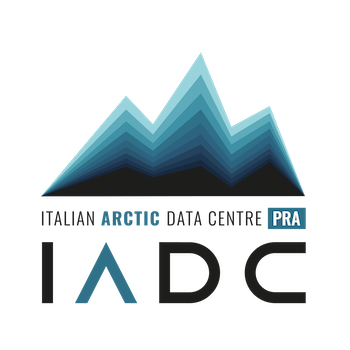Climate Change Tower Turbulence Data
The Climate Change Tower Integrated Project (CCT-IP) represents the guide lines of the italian research in the arctic and aims to study the interaction between all the components of the climate system in the Arctic. The Amundsen-Nobile Climate Change Tower (CCT) is the key infrastructure of the project, and provides continuous acquisition of the atmospheric parameters at different heights as well as at the interface between the surface and the atmosphere.
Turbulent parameters are measured at the Amundsen-Nobile Climate Change Tower (CCT) by means of a Gill R3 sonic anemometer installed at 7.5 m from the ground since 2010. It measures the three components of the wind (u, v and w) and the sonic temperature at a rate of 20 Hz. These micro-meteorological measurements are complemented by standard meteorological ones at 4 levels: 2, 5, 10 and 33 m (acquisition time step equal to 1 minute). From these measurements, sensible heat flux, friction velocity and roughness length are calculated.
Wind components and sonic temperature measurements were used to estimate friction velocity and kinematic heat flux. Before computing the micrometeorological parameters, a preliminary analysis is applied in order to assess the data quality and to remove low quality records. After the quality analysis application, mean values of the turbulence statistics were computed following two coordinate rotations to ensure the mean lateral and vertical velocities were zero (McMillen, 1988). Half-hour turbulent statistics (heat fluxes and friction velocity) were derived using two time-scales: a standard averaging time of 30 min and a reduced one (2 min) necessary for filtering out submeso motions contributions that can greatly alter the estimation of turbulent fluxes in a strong and long-lived stable BL. The short averaging time scale was evaluated on the basis of spectral analysis of data in order to include all turbulent scales, but excluding submeso motions (larger than turbulence). The turbulent statistics evaluated over the short subsets and then re-averaged over 30 min following Vickers and Mahrt (2006).
Turbulent parameter relative to unfavorable wind direction ([150÷270] degrees) for which the tower was upwind of the sonic anemometer were not discarded but are flagged (flagdir=1) in the final dataset. More, the percentage of NaNs relative to each run is indicated.
The wind speed vertical profile measured by slow response standard meteorological anemometers at 2, 5, 10 and 33 m was used for estimating the roughness length assuming a typical log wind profile under statically neutral conditions.
Mahrt, L., 1998. Flux Sampling Errors for aircraft and towers. J. Atmos. Ocean. Technol. 15, 416-429.
Mc Millen, R.T., 1988. An Eddy correlation technique with extended applicability to non-simple terrain. Boundary-Layer Meteorol. 43, 231-245.
Vickers D, Mahrt L. 2006. A solution for flux contamination by mesoscale motions with very weak turbulence. Boundary-Layer Meteorol. 118: 431–447. https://doi.org/10.1007/s10546-005-9003-y .
Zahn, E., Chor, T.L., Dias, N. L., 2016. A Simple Methodology for Quality Control of Micrometeorological Datasets. American Journal of Environmental Engineering 6(4A): 135-142 DOI: 10.5923/s.ajee.201601.20.
Simple
- Date (Creation)
- 2022-11-15
- Date (Publication)
- 2022-11-15
- Date (Revision)
- 2022-11-15
- Identifier
- https://metadata.iadc.cnr.it/geonetwork/srv/api/records/2cdf599e-5f25-4065-9e1f-821b17ee2dc8
- Purpose
-
These boundary layer (BL) parameters describe the interaction of the mean flow with the surface and the energy and momentum exchanges with the atmosphere. Apart from being essential to the definition of the stability function in the Monin-Obukhov similarity theory, these local measurements can be used in meteorological or climatological reanalyzes (e.g. ERA5). Further, global and regional climate models are extremely sensitive to a correct representation of atmospheric energy fluxes, especially over snow-covered polar surfaces, where atmospheric conditions can become strongly and persistently stable.
- Status
- On going
- Maintenance and update frequency
- As needed
- Theme
-
-
SIOS
-
-
GEMET - INSPIRE themes, version 1.0
-
-
Atmospheric conditions
-
-
GCMD - Science Keywords
-
-
AIR TEMPERATURE
-
BOUNDARY LAYER WINDS
-
HUMIDITY
-
ATMOSPHERIC PRESSURE
-
SURFACE WINDS
-
TURBULENCE
-
ATMOSPHERIC WINDS
-
BOUNDARY LAYER TEMPERATURE
-
SURFACE ROUGHNESS
-
HEAT FLUX
-
-
GCMD - Instruments
-
-
Hygrometers
-
BAROMETERS
-
THERMOMETERS
-
SONIC ANEMOMETER
-
ANEMOMETERS
-
-
GCMD - Locations
-
-
SVALBARD AND JAN MAYEN
-
ARCTIC
-
-
GCMD - Providers
-
-
ITALY
-
-
IADC Research Activities
-
-
Chemistry and physics of the atmosphere
-
- Use limitation
- Creative-Commons CC BY-NC-SA 4.0
- Unique resource identifier
- IADC Italian Arctic Data Center
- Association Type
- dependency
- Initiative Type
- Project
- Spatial representation type
- Text, table
- Denominator
- 1
- Metadata language
- English
- Topic category
-
- Climatology, meteorology, atmosphere
))
- Begin date
- 2009-10-15
- End date
- 2050-12-31 Now
- Unique resource identifier
- WGS84
- Distribution format
-
-
ISO19139
(
1
)
-
ISO19139
(
1
)
- OnLine resource
- Landing page ( WWW:LINK-1.0-http--link )
- OnLine resource
-
OPeNDAP URL
(
WWW:LINK-1.0-http--opendap
)
Climate Change Tower Turbulence Data
- OnLine resource
- NetCDF Direct Download ( WWW:DOWNLOAD-1.0-http--download )
- OnLine resource
- Project RIS ( WWW:LINK-1.0-http--link )
- Hierarchy level
- Dataset
Domain consistency
Conformance result
- Date (Publication)
- 2010-12-08
- Explanation
-
This data set is conformant with the INSPIRE Implementing Rules for the interoperability of spatial data sets and services
- Pass
- Yes
- Statement
-
Wind components and sonic temperature measurements were used to estimate friction velocity and kinematic heat flux. Before computing the micrometeorological parameters, a preliminary analysis is applied in order to assess the data quality and to remove low quality records. After the quality analysis application, mean values of the turbulence statistics were computed following two coordinate rotations to ensure the mean lateral and vertical velocities were zero (McMillen, 1988). Half-hour turbulent statistics (heat fluxes and friction velocity) were derived using two time-scales: a standard averaging time of 30 min and a reduced one (2 min) necessary for filtering out submeso motions contributions that can greatly alter the estimation of turbulent fluxes in a strong and long-lived stable BL. The short averaging time scale was evaluated on the basis of spectral analysis of data in order to include all turbulent scales, but excluding submeso motions (larger than turbulence). The turbulent statistics evaluated over the short subsets and then re-averaged over 30 min following Vickers and Mahrt (2006).
Turbulent parameter relative to unfavorable wind direction ([150÷270] degrees) for which the tower was upwind of the sonic anemometer were not discarded but are flagged (flagdir=1) in the final dataset. More, the percentage of NaNs relative to each run is indicated.
- File identifier
- 2cdf599e-5f25-4065-9e1f-821b17ee2dc8 XML
- Metadata language
- English
- Character set
- UTF8
- Hierarchy level
- Dataset
- Date stamp
- 2025-05-12T14:24:58
- Metadata standard name
-
ISO 19139
- Metadata standard version
-
1.0
Overviews

Spatial extent
))
Provided by
